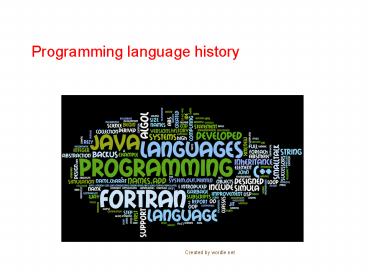Programming language history - PowerPoint PPT Presentation
1 / 16
Title:
Programming language history
Description:
a city in Shinar where the building of a tower is held ... Niklaus Wirth. 1984. Fortran, BNF. John Backus. 1977. Algol, Structured programming. Edsger Dijkstra ... – PowerPoint PPT presentation
Number of Views:110
Avg rating:5.0/5.0
Title: Programming language history
1
Programming language history
- Created by wordle.net
2
03-60-440 Programming language history
- Tower of Babel, CACM cover, Jan. 1961
- Babel
- a city in Shinar where the building of a tower is
held in Genesis to have been halted by the
confusion of tongues - a confusion of sounds or voices
- a scene of noise or confusion
- --Webster
3
(No Transcript)
4
Evolution of programming languages
logic
OO
Imperative
functional
1955 1960 1965 1970 1975 1980 1985 1990 1995 2000
2005 2007
Fortran I
Lisp
Fortran II
Algol 58
Algol 60
Cobol
Fortran IV
Simula I
Basic
PL/I
Simula 67
Algol 68
Pascal
Prolog
C
C
Fortran 77
Scheme
Modula-2
ML
Smalltalk 80
Smalltalk 80
Ada
Common Lisp
C
C
Oberon
QuickBasic
Fortran 90
Visual Basic
Haskell
Delphi
Delphi
Goedel
Mercury
Ada95
Ada95
Java
Java
CAML
Fortran 2003
C
mapReduce
5
FORTRAN (Formula Translator)
- It is the first high level programming language
- The Preliminary Report, 1954, claims that FORTRAN
will virtually eliminate coding and debugging. - Developed by John Backus, at IBM.
- Major versions Fortran II in 1958, Fortran IV in
1961, Fortran 77, Fortran 95, Fortran 2003 (OO
support). - Initial versions rely heavily on GOTO statement
- It remains the language of choice for high
performance numerical computing in science and
engineering communities - Example applications
- Weather and climate modeling, solar system
dynamics, simulation of auto crashes.
6
ALGOL (ALGOrithmic Language)
- de facto standard way to report algorithms in
print - Designed to improve Fortran
- John Backus developed the Backus Normal Form
method of describing programming languages. - ALGOL 60 inspired many languages that followed
it - "ALGOL 60 was a great improvement on its
successors. - The full quote is "Here is a language so far
ahead of its time, that it was not only an
improvement on its predecessors, but also on
nearly all its successors" --C. A. R Hoare - procedure Absmax(a) Size(n, m) Result(y)
Subscripts(i, k) - value n, m array a integer n, m, i, k real
y - comment The absolute greatest element of the
matrix a, of size n by m is transferred to y, and
the subscripts of this element to i and k - begin integer p, q
- y 0 i k 1
- for p1 step 1 until n do
- for q1 step 1 until m do
- if abs(ap, q) gt y then
- begin y abs(ap, q)
- i p k q
- end
- end Absmax
7
The origin of OOP Simula and Smalltalk
- Simula 67
- Developed in 1960s, by Ole-Johan Dahl
- Simulation of complex systems
- Introduced objects, classes, and inheritance.
- Smalltalk
- Developed at Xerox PARC, initially by Alan Kay,
in 1970s. - First full implementation of an object-oriented
language (data abstraction, inheritance, and
dynamic type binding) - Pioneered the graphical user interface design
- Promoted OOP
8
Java (and comparison with C)
- Derived from C. Smaller, simpler, and more
reliable - e.g., no pointers, no multiple inheritance,
automated garbage collection. - Design philosophy
- Java was created to support networking computing,
embedded systems. - C was created to add OO to C. Support systems
programming. - Version history
- 1.0 1996
- 1.2 1998, Introduced Swing, JIT
- 1.4 2002, assert, regular expression, XML
parsing - 1.5 (5) 2004, generics, enumeration
- 6 2006 web service support(JAX WS)
9
Java and C
- The syntax of both languages is similar to C,
which was in turn derived from C. - Both languages were designed to be object
oriented from the ground up unlike C, they
were not designed to be compatible with C. - Both provide parametric polymorphism by generic
classes. - Both languages rely on a virtual machine.
- Both the Java VM and the .NET platform optimize
code at runtime through just-in-time compilation
(JIT). - Both include garbage collection.
- Both include boxing and unboxing of primitive
types, allowing numbers to be handled as objects.
- Both include foreach, an enhanced iterator-based
for loop.
10
Foreach statement an example of abstraction
- Java iteration traditional way (before 2004)
- List names new ArrayList()
- names.add("a")
- names.add("b")
- names.add("c")
- for (Iterator it names.iterator()
it.hasNext() ) - String name (String)it.next()
- System.out.println(name.charAt(0))
- Java 1.5
- for (String name names) System.out.println(name.c
harAt(0)) - New loop structure is more declarative.
11
XML programming
- XPath
- XQuery
- XSLT
- JSP
- Web service programming
12
IDE (Integrated Development Environment)
- IDE for Java Eclipse
13
Turing award (Nobel prize in computer science)
recipients relevant to this course
14
Programming languages job market
- Source CACM, Volume 48 Issue 10, October 2005
- Data range April 2002 to April 2005, job posting
in north America - Web programming XML, web scripting, etc.
appeared in 42.6 of job ads.
15
Programming languages used
Compiled by François Labelle from statistics on
open-source projects at SourceForge
16
- CNN 2006
- http//money.cnn.com/magazines/moneymag/bestjobs/t
op50/index.html































